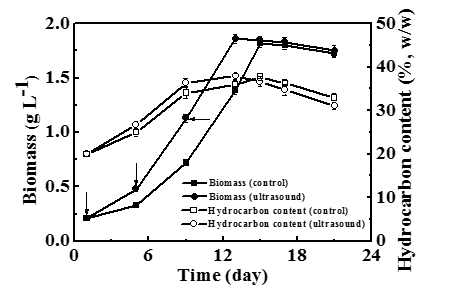Microalgae are regarded as sunlight-driven cell factories that convert CO2 into renewable bioresources, which can be used as a potential feedstock for biofuel production. Compared with other energy crops, microalgae possess several advantages, including high photosynthetic efficiency, fast growth, high-oil content, and a smaller land area requirement. Botryococcus braunii has been proposed as a potential source for biofuel production due to its excellent ability of producing liquid hydrocarbons (about 75 % by weight of its dry biomass). However, B. braunii is one of slow-growing green microalgae, and its growth and hydrocarbon productivity should be improved before it can be utilized in commercial applications.
Recently, an effective ultrasound stimulation strategy was developed and applied in the cultivation of B. braunii by Prof. LIU Chunzhao’s group at Institute of Process Engineering, Chinese Academy of Sciences. The results showed that the most effective sonication strategy was to subject the cells to three 5-min ultrasonic treatments at a 4-day interval using a fixed frequency of 40 kHz and power of 240 W, and the ultrasound treated algal cells showed the highest biomass productivity of 0.043 g L?1 day?1 and the highest hydrocarbon productivity of 13.1 mg L?1 day?1 among all ultrasound treatments tested. The improved productivity was proved to be mainly due to the enhancement of both endogenous indole-3-acetic acid (IAA) biosynthesis and membrane permeability in the ultrasound stimulated algal cells (BioEnergy Research (2014) 7: 986–992).
The efficient ultrasonic stimulation strategy also showed good performance for the algal culture in an indoor 2-L airlift bioreactor and an outdoor 200-L bag bioreactor (Fig 1 and Fig 2). The hydrocarbon productivity was significantly improved by ultrasound treatment at both conditions (Bioresource Technology (2014) 167: 376–382).

Effective of 4-day interval ultrasonic treatment on the biomass and hydrocarbon production of B. braunii at indoor 2-Lairlift bioreactor culture.

Effective of 4-day interval ultrasonic treatment on the biomass and hydrocarbon production of B. braunii at outdoor 200-Lbag bioreactor culture. (Image by IPE)
Together, these results not only illustrate the immense potential for an enhanced understanding on ultrasound-stimulated algal cells but also provide a powerful process intensification method to improve the biomass and hydrocarbon productivity of B. braunii practice.
This work was supported financially by the Major State Basic Research Development Program (973 Project) of China (Nos. 2011CB200903 & 2011CB200905), the National Natural Science Foundation of China (No. 21106165), the Knowledge Innovation Program of the Chinese Academy of Sciences (Nos. KSZD-EW-Z-015 & YZ200947), and the Chinese Academy of Sciences Fellowships for Young International Scientists (No. 2011Y1GA01).
(Team of Biomass Engineering: Wang Shikai)
 Search
Search




 京公网安备110402500047号
京公网安备110402500047号